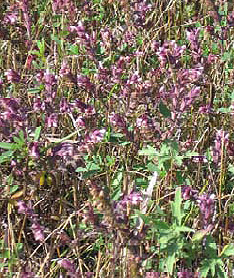Red Bartsia
 Odontites serotina
Odontites serotina
Origin
It first appeared in the Interlake region of Manitoba in the 1950s. It was introduced from German crates which were shipped to the Canadian Armed Forces Base at Gimli.
Status
Until recently the main region of infestation included areas around Gimli, Meleb and Fraserwood. New areas that have been infested are Souris, Carman and parts of Stonewall, Winnipeg, and Selkirk.
Impacts
Plants produce 1400 seeds a year, which are equipped with coarse hairs that stick to clothing, fur, and vehicles enabling them to travel long distances.
Red Bartsia outcompetes native vegetation. Poses a serious economic concern for pastures and hayland.
Where to Look
It is a weed found primarily in pastures, hayfields, and roadsides.
 Identification
Identification
Stems: Are erect and branching to reach heights of 15-30cm.
Leaves: Narrow bearclasping leaves, in pairs, about 3 cm in length. Stem and leaves are hairy.
Flowers: Reddish purple in color develop in spike-like clusters on the top half of the stem. Red Bartsia flowers in late spring.
Prevention
Prevention is the best protection. Early sightings can be sprayed with herbicide; and in fields not suitable for chemicals, cultivation and planting competitive crops is an effective control method.
Â
Photo credits:Â Close up of flowers: http://upload.wikimedia.org/wikipedia/en/d/db/Red_bartisa_800.jpg; View of many plants: John Johnston, Manitoba Weed Supervisor Association.
Â
Resources
2011 Rural Municipality Distribution Map
2010 Rural Municipality Distribution Map
Red Bartsia MWSA 2009 Survey Map
Best Management Practices 2010
Alberta Invasive Plant Council Fact Sheet
Â
Back to Terrestrial Invasive Species List
Â
© Copyright 2004-2024 - CMS Made Simple
This site is powered by CMS Made Simple version 1.4.1


